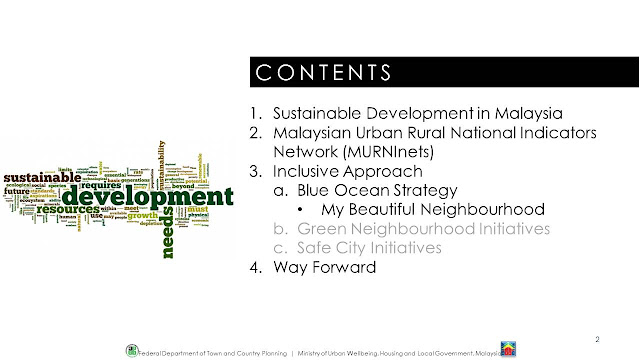INTERNATIONAL CONFERENCE ON SUSTAINABLE DEVELOPMENT PRACTICE (ICSDP)
17 - 18 SEPTEMBER 2014
COLUMBIA UNIVERSITY NEW YORK
Theme : Sustainable Cities: Inclusive, Resilient and Connected
ABSTRACT
PROMOTING SUSTAINABLE AND HAPPY COMMUNITIES THROUGH THE MALAYSIAN URBAN RURAL NATIONAL INDICATORS NETWORK (MURNInets)
Dr. Dahlia Rosly
Director General
Federal Department of Town and Country Planning
Ministry of Urban Wellbeing, Housing and Local Government
dahlia@townplan.gov.my
Dr. Azmizam Abdul Rashid
Principal Assistant Director
Federal Department of Town and Country Planning
Ministry of Urban Wellbeing, Housing and Local Government
azmizam@townplan.gov.my
The Federal Department of Town and Country Planning (FDTCP), Peninsular Malaysia is a focal point for the implementation of Malaysian Urban Rural National Indicators Network for Sustainable Development (MURNInets) which now incorporates happiness indicators into its framework. This is in line with the Ministry of Urban Wellbeing, Housing and Local Government’s commitment in promoting sustainable communities. FDTCP has introduced Malaysian Urban Indicators Network (MURNInet) in 1998 as an innovative system to determine the sustainability level of urban areas by using a set of urban indicators. MURNInet was a program to assess the performance and level of sustainability of Malaysian towns. In line with this, MURNInet is rebranded and is now known as MURNInets. The new features of MURNInets include 36 sets of compulsory indicators grouped under 21 themes under 6 dimensions. Most of the targets and standards for the selected indicators were adjusted according to hierarchy of local authorities. The Analytical Hierarchical Process (AHP) technique was introduced and applied to derive at the sustainability index by giving weights to each dimension and themes and rating to each indicators. The online portal has also been reviewed and redeveloped thoroughly and improvements are made to enable users i.e the Local Authorities, State Authorities, Data Providing Agencies and the public to access MURNInets to view data or even to obtain information relating to sustainable urban indicators. MURNInets shall give a better reflection on the progress towards sustainable development in Malaysia. MURNInets can be monitored using the developed indices in a wider sense in terms of urban development and work as a guideline for urban managers working towards attaining and maintaining sustainable cities. MURNInets has been recognised as a very important tool to measure sustainability of towns and cities in the country by the National Physical Planning Council (NPPC) which is the highest authority on physical planning in Malaysia which is chaired by the Prime Minister of Malaysia.
Keywords : sustainability, happiness, indicators
Please find more detail about ICSD 2014



























